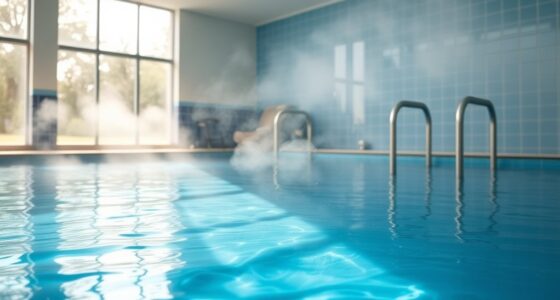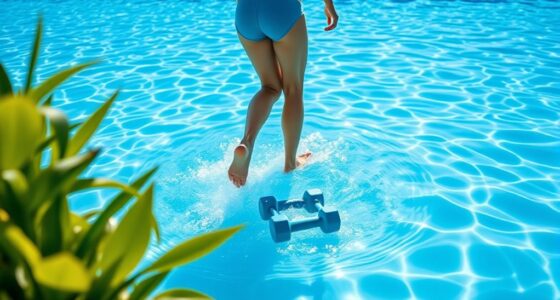Aquatic therapy helps relieve joint pain from arthritis by using warm water that relaxes muscles and reduces joint stiffness. The water’s buoyancy supports your body, decreasing stress on your joints and making movement easier and less painful. Resistance in the water helps strengthen muscles around your joints, improving stability. Plus, the calming environment promotes relaxation, which can lessen arthritis symptoms. Keep exploring to discover how you can make the most of water’s healing benefits.
Key Takeaways
- Warm water relaxes muscles, reduces joint stiffness, and soothes arthritis pain.
- Buoyancy supports body weight, decreasing joint stress during movement.
- Water resistance strengthens muscles around joints, enhancing stability and reducing pain.
- The soothing environment promotes relaxation, stress reduction, and improved overall joint health.
- Aquatic exercises improve mobility, balance, and posture, decreasing fall risk and joint discomfort.

Have you ever considered how water-based therapy can ease arthritis symptoms? When you step into a pool designed for therapeutic purposes, you immediately notice the calming effect of the water. One of the key factors that make aquatic therapy effective is the water temperature. Warm water, typically between 88 and 92 degrees Fahrenheit, helps relax your muscles and soothe joint pain. This warmth increases blood flow, reduces stiffness, and makes movement less painful. As a result, you can perform exercise routines more comfortably than on land, where joints often feel rigid and painful. The right water temperature creates an inviting environment that encourages you to move more freely, which is vital for improving joint function and reducing swelling. Additionally, adaptive learning technologies can be used to personalize aquatic therapy programs, ensuring exercises are tailored to individual needs and progress. Your exercise routines in water are tailored to minimize joint stress. Unlike land-based exercises that can strain your joints, aquatic exercises allow you to work out with less impact. The buoyancy of water supports your body, reducing the weight bearing on your joints by up to 90%. This support means you can perform movements that might be painful or impossible on land, such as walking, stretching, or gentle aerobics. Because your joints aren’t subjected to the same pounding, you’re more likely to stick with your routine and gradually build strength and flexibility. The resistance provided by water also helps strengthen muscles around your joints, offering additional stability and reducing the feeling of joint instability often associated with arthritis. You can incorporate a variety of exercise routines into your aquatic therapy sessions, from simple range-of-motion movements to more structured aerobic exercises. Many programs focus on gentle, low-impact activities that improve mobility without overloading your joints. Over time, consistent participation can lead to decreased pain and increased joint function. Water-based routines also promote better posture and balance, which can prevent falls and further joint injuries. The soothing nature of water encourages relaxation and can help reduce stress, which often exacerbates arthritis symptoms. Plus, the social aspect of group aquatic classes can motivate you to stay committed to your therapy.
Frequently Asked Questions
Can Aquatic Therapy Cure Arthritis Permanently?
You might wonder if aquatic therapy can cure arthritis permanently. While it’s a helpful treatment, there are cure limitations because arthritis is a chronic condition. Aquatic therapy effectively reduces joint pain and improves mobility, but it doesn’t eliminate the disease itself. Its therapy effectiveness varies by individual, so it’s best used as part of a holistic management plan rather than a permanent cure.
How Often Should I Attend Aquatic Therapy Sessions?
You should attend aquatic therapy sessions based on your condition and your healthcare provider’s advice. Typically, a good starting point is 2 to 3 sessions per week, which balances effective treatment and recovery time. This session frequency allows for ideal scheduling, helping you build strength and flexibility without overexertion. Always follow your therapist’s recommendations to tailor the schedule to your progress and guarantee the best results.
Are There Any Age Restrictions for Aquatic Therapy?
When considering age restrictions for aquatic therapy, you should know that most programs prioritize swimmer safety, but they typically welcome a wide age range. Children and seniors often benefit from tailored sessions. It’s important to check with your provider, as they may have specific guidelines based on individual health or swimming ability. Overall, aquatic therapy is safe for many age groups, provided safety protocols are followed and supervision is adequate.
What Is the Cost of Aquatic Therapy Treatments?
Did you know that aquatic therapy costs vary widely, with an average session ranging from $50 to $150? You might wonder about insurance coverage—many plans partially cover treatments, especially for chronic conditions. Treatment duration also influences costs; sessions typically last 30 to 60 minutes. Check with your provider to understand your coverage and plan accordingly, so you can access this effective therapy without unexpected expenses.
Will Aquatic Therapy Interfere With My Medications?
You might wonder if aquatic therapy affects your medications. Generally, aquatic therapy doesn’t interfere with medication interactions, but it’s crucial to discuss your treatment plan with your healthcare provider. They can advise you on therapy timing and ensure your medications won’t cause issues during sessions. Always inform your therapist about your medications to tailor the therapy safely and effectively, helping you get the best benefits without concerns.
Conclusion
Think of aquatic therapy as a gentle sailboat gliding across calm waters, easing your joints with each peaceful stroke. Just as the ocean’s embrace soothes the soul, pools provide a sanctuary where arthritis pain can fade into the background. Embrace this voyage, and let the buoyant waters carry you toward renewed strength and comfort. With patience and persistence, you’ll find yourself steering life’s currents more smoothly, guided by the healing power beneath the surface.









